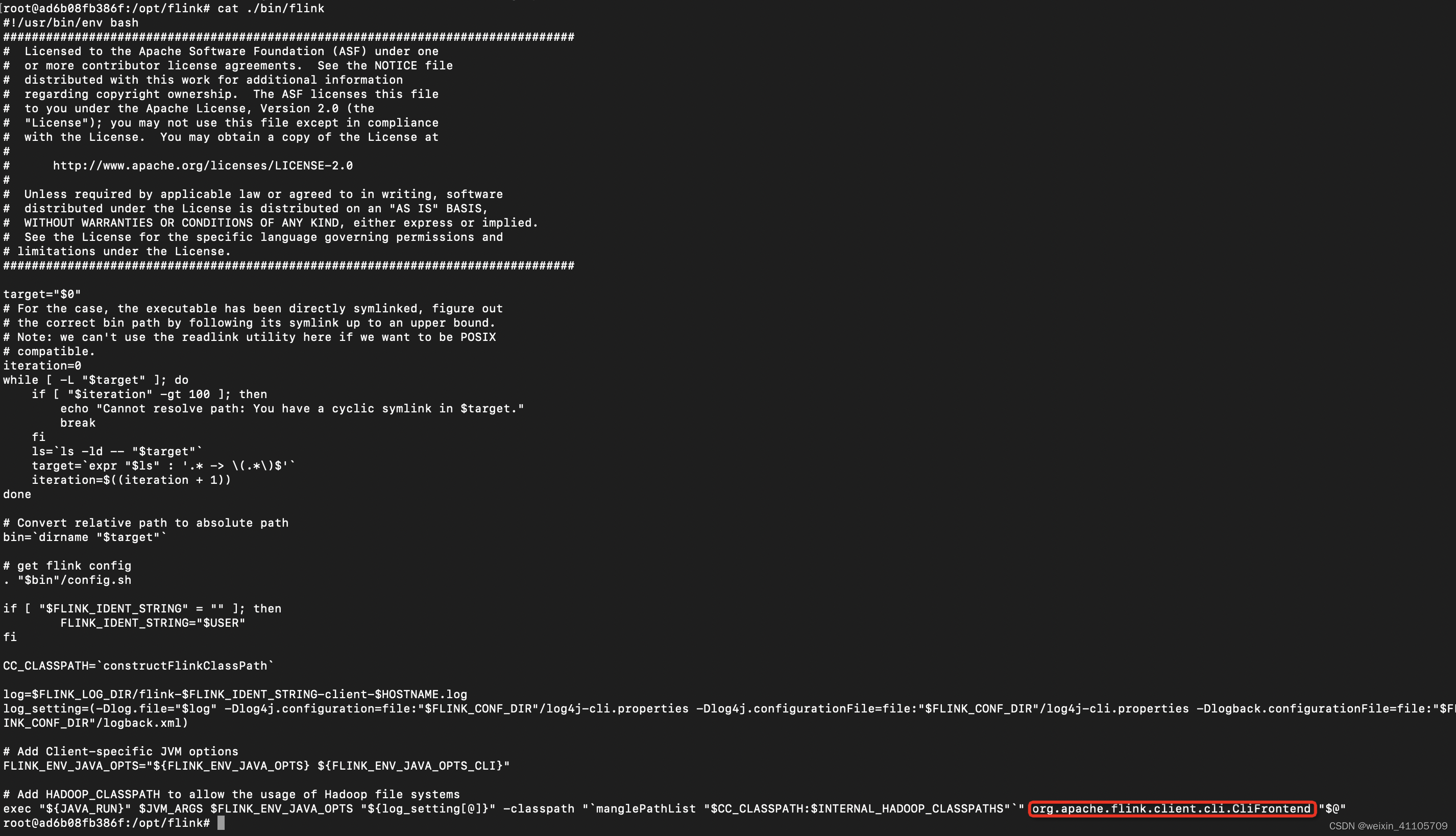一、启动脚本分析
1、 WordCount启动命令
bin/flink run examples/streaming/SocketWindowWordCount.jar --hostname localhost --port 9000
2、bin/flink 脚本分析

从上图中我圈的红色部分可以看出,最终调用的是“org.apache.flink.client.cli.CliFrontend”这个类。
二、CliFrontend启动类分析
1、main方法
从下面的代码可以看出,main方法中首先是寻找配置文件路径,然后加载配置文件等等,最后重要的代码就是new 了一个CliFrontend对象出来,然后调用cli.parseAndRun(args)方法;
public static void main(final String[] args) {
EnvironmentInformation.logEnvironmentInfo(LOG, "Command Line Client", args);
// 1. find the configuration directory
final String configurationDirectory = getConfigurationDirectoryFromEnv();
// 2. load the global configuration
final Configuration configuration =
GlobalConfiguration.loadConfiguration(configurationDirectory);
// 3. load the custom command lines
final List<CustomCommandLine> customCommandLines =
loadCustomCommandLines(configuration, configurationDirectory);
int retCode = 31;
try {
final CliFrontend cli = new CliFrontend(configuration, customCommandLines);
SecurityUtils.install(new SecurityConfiguration(cli.configuration));
retCode = SecurityUtils.getInstalledContext().runSecured(() -> cli.parseAndRun(args));
} catch (Throwable t) {
final Throwable strippedThrowable =
ExceptionUtils.stripException(t, UndeclaredThrowableException.class);
LOG.error("Fatal error while running command line interface.", strippedThrowable);
strippedThrowable.printStackTrace();
} finally {
System.exit(retCode);
}
}
2、cli.parseAndRun(args)方法
这个方法并没有做什么实质性的动作,只是去解析了我们命令行的参数,通过参数选择调用适当方法,比如我们上面的命令输入的是run,后面就会调用run(params)方法;
public int parseAndRun(String[] args) {
// check for action
if (args.length < 1) {
CliFrontendParser.printHelp(customCommandLines);
System.out.println("Please specify an action.");
return 1;
}
// get action
String action = args[0];
// remove action from parameters
final String[] params = Arrays.copyOfRange(args, 1, args.length);
try {
// do action
switch (action) {
case ACTION_RUN:
run(params);
return 0;
case ACTION_RUN_APPLICATION:
runApplication(params);
return 0;
case ACTION_LIST:
list(params);
return 0;
case ACTION_INFO:
info(params);
return 0;
case ACTION_CANCEL:
cancel(params);
return 0;
case ACTION_STOP:
stop(params);
return 0;
case ACTION_SAVEPOINT:
savepoint(params);
return 0;
case "-h":
case "--help":
CliFrontendParser.printHelp(customCommandLines);
return 0;
case "-v":
case "--version":
String version = EnvironmentInformation.getVersion();
String commitID = EnvironmentInformation.getRevisionInformation().commitId;
System.out.print("Version: " + version);
System.out.println(
commitID.equals(EnvironmentInformation.UNKNOWN)
? ""
: ", Commit ID: " + commitID);
return 0;
default:
System.out.printf("\"%s\" is not a valid action.\n", action);
System.out.println();
System.out.println(
"Valid actions are \"run\", \"run-application\", \"list\", \"info\", \"savepoint\", \"stop\", or \"cancel\".");
System.out.println();
System.out.println(
"Specify the version option (-v or --version) to print Flink version.");
System.out.println();
System.out.println(
"Specify the help option (-h or --help) to get help on the command.");
return 1;
}
} catch (CliArgsException ce) {
return handleArgException(ce);
} catch (ProgramParametrizationException ppe) {
return handleParametrizationException(ppe);
} catch (ProgramMissingJobException pmje) {
return handleMissingJobException();
} catch (Exception e) {
return handleError(e);
}
}
3、cli.run(params)方法
在这个方法里面首先去解析命令参数,并判断有没有help,有的话直接输出并返回,然后去解析一些运行参数,获取依赖jar包的信息,并根据以上信息去生成一个有效的配置类,最后调用cli.executeProgram(effectiveConfiguration, program)方法,注意这里会生成一个program,后续的类加载器的使用就是在这里设置的;
protected void run(String[] args) throws Exception {
LOG.info("Running 'run' command.");
final Options commandOptions = CliFrontendParser.getRunCommandOptions();
final CommandLine commandLine = getCommandLine(commandOptions, args, true);
// evaluate help flag
if (commandLine.hasOption(HELP_OPTION.getOpt())) {
CliFrontendParser.printHelpForRun(customCommandLines);
return;
}
final CustomCommandLine activeCommandLine =
validateAndGetActiveCommandLine(checkNotNull(commandLine));
final ProgramOptions programOptions = ProgramOptions.create(commandLine);
final List<URL> jobJars = getJobJarAndDependencies(programOptions);
final Configuration effectiveConfiguration =
getEffectiveConfiguration(activeCommandLine, commandLine, programOptions, jobJars);
LOG.debug("Effective executor configuration: {}", effectiveConfiguration);
try (PackagedProgram program = getPackagedProgram(programOptions, effectiveConfiguration)) {
executeProgram(effectiveConfiguration, program);
}
}
4、cli.executeProgram(effectiveConfiguration, program)方法
这个方法就做了一件事,就是去调用ClientUtils.executeProgram(
new DefaultExecutorServiceLoader(), configuration, program, false, false);
protected void executeProgram(final Configuration configuration, final PackagedProgram program)
throws ProgramInvocationException {
ClientUtils.executeProgram(
new DefaultExecutorServiceLoader(), configuration, program, false, false);
}
三 ClientUtils工具类分析
1、ClientUtils.executeProgram方法
可以看出分为几个步骤,先是获取用户配置使用的类加载器,然后设置成当前的上下文类加载器,再设置上下文环境,最后通过代理的方式执行用户jar包的main方法;
public static void executeProgram(
PipelineExecutorServiceLoader executorServiceLoader,
Configuration configuration,
PackagedProgram program,
boolean enforceSingleJobExecution,
boolean suppressSysout)
throws ProgramInvocationException {
checkNotNull(executorServiceLoader);
/**
*1、获取用户类加载器(这里的用户类加载其实是配置文件里面有个参数可以进行配置(CoreOptions.CLASSLOADER_RESOLVE_ORDER)
* 这个参数会决定使用ChildFirstClassLoader还是ParentFirstClassLoader)
* 详情请看 buildUserCodeClassLoader方法
*/
final ClassLoader userCodeClassLoader = program.getUserCodeClassLoader();
//2、获取当前上下文类加载器(这里用于后续finally重新设置会此类加载器)
final ClassLoader contextClassLoader = Thread.currentThread().getContextClassLoader();
try {
//3、重新设置当前上下文
Thread.currentThread().setContextClassLoader(userCodeClassLoader);
LOG.info(
"Starting program (detached: {})",
!configuration.getBoolean(DeploymentOptions.ATTACHED));
ContextEnvironment.setAsContext(
executorServiceLoader,
configuration,
userCodeClassLoader,
enforceSingleJobExecution,
suppressSysout);
//设置流处理任务的环境上下文,也就是我们平常使用的StreamExecutionEnvironment.getExecutionEnvironment()获取到的上下文
StreamContextEnvironment.setAsContext(
executorServiceLoader,
configuration,
userCodeClassLoader,
enforceSingleJobExecution,
suppressSysout);
try {
//执行用户jar包的main方法
program.invokeInteractiveModeForExecution();
} finally {
ContextEnvironment.unsetAsContext();
StreamContextEnvironment.unsetAsContext();
}
} finally {
Thread.currentThread().setContextClassLoader(contextClassLoader);
}
}




















 7324
7324











 被折叠的 条评论
为什么被折叠?
被折叠的 条评论
为什么被折叠?








